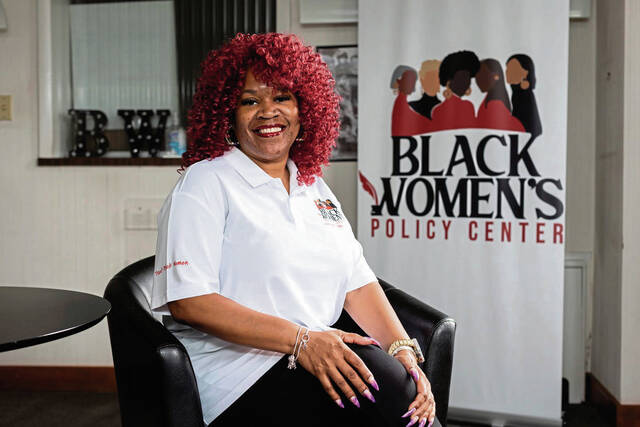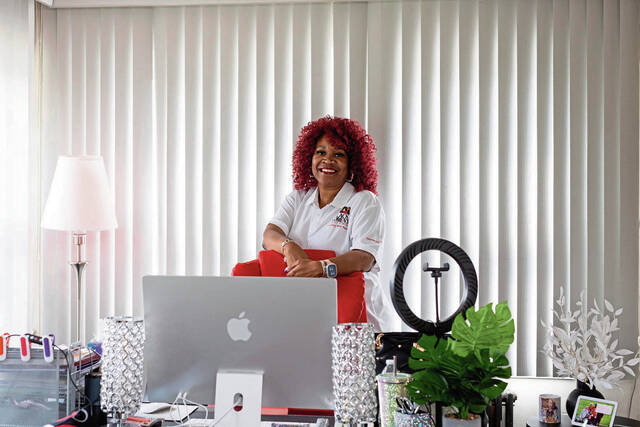Equal Pay Act turns 60, but wage gaps remain between men and women
Phylliss Ewell was a home health aide who loved caring for people in need.
She was a single mother who worked two, sometimes three, jobs to support herself and two children she raised in Duquesne in the 1970s.
Despite Ewell’s multiple jobs, the family still qualified for programs such as food stamps and medical assistance.
“That shows the inequities that she was facing around pay, access to career training, good-paying jobs,” said her daughter, Rochelle Jackson. “She worked however many jobs she had to make sure we had a Christmas, make sure we had school clothes and things like that.”
Jackson saw that struggle — and experienced it herself later in life. It helped prompt her to take action by founding a nonprofit to address pay equity and other policy issues.
This year marks the 60th anniversary of the Equal Pay Act being signed into law by President John F. Kennedy. It was landmark legislation, which stated that employees, regardless of gender, must be paid equal pay “for equal work on jobs the performance of which requires equal skill, effort and responsibility, and which are performed under similar working conditions.”
It was a critical step forward, but not the final destination.
Since 1963, numerous laws and policies have been put into place to address pay discrepancies between men and women and other forms of workplace discrimination. Some notable cases have roots in Pittsburgh.
Yet the wage gap persists.
In the early 1960s, although they made up one-third of the labor force, women were paid 60% as much as men. Women also tended to be employed in low-wage jobs that were considered appropriate for them, according to the JFK Presidential Library and Museum.
Six decades later, women comprise more than half of the labor force at nearly 57% in 2022, according to the Bureau of Labor Statistics.
Over the years, the pay difference has shrunk. But it has not disappeared.
In 2022, women earned an average of 82% of what men earned, according to a Pew Research Center analysis of median hourly earnings of both full- and part-time workers. That percentage hasn’t budged much in two decades, Pew found. The numbers are similar to where the pay gap stood in 2002, when women earned 80% as much as men.
Those wage gaps widen upon examination of race.
Asian American, Native Hawaiian and Pacific Islander women make an average of 80 cents on the dollar, federal data show.
In 2022, Black and Hispanic or Latina women’s median weekly pay for full-time work was substantially less than white men’s — just 67.4% and 61.4%, respectively, according to the Institute for Women’s Policy Research.
“Black and Latina women are overrepresented in service occupations, the lowest-
paying intermediate occupations, but whether high or low paying, their median earnings are lower than men’s in the same intermediate occupational group,” the Washington, D.C.-based nonprofit research organization found.
The wage gap widens when all workers with weekly earnings are considered, because women are more likely than men to be in part-time jobs, IWPR noted. In 2022, the gender weekly earnings ratio for all workers was 77.4%.
It’s an issue that affects many job sectors. In early August, Spotlight PA reported that Penn State is facing at least one allegation of wage discrimination, while salary data show the university’s gender pay gap is among the worst in the Big Ten.
The report found across Penn State’s statewide system, female instructional staff earn on average about 80% of what their male colleagues make, according to the federal Integrated Postsecondary Education Data System. Penn State combines data from all of its campuses when reporting to IPEDS.
The university said in a statement it does not comment on pending litigation. As for the wage data, Penn State also said in a statement that IPEDS data should not be used to measure equity or draw conclusions because factors such as years of experience, subject area, tenure and nontenure track faculty, highest-earned degree and “years in rank at Penn State” are not included.
Equal pay for equal work
When the Equal Pay Act was signed in 1963, efforts to address workplace discrimination had been underway for decades.
In 1870, Congress passed an amendment that would give equal pay to female clerks hired by the federal government. In 1945, a comprehensive Women’s Equal Pay Act was introduced to Congress. It failed to pass, followed by similar proposals over the years.
“ ‘Equal pay for equal work’ became a slogan in the 1930s,” said Jessie Ramey, an associate professor of gender studies at Chatham University.
“By 1963, women already had been in the workforce. And, of course, women of color in this country had always been working,” she said. “But in 1963, women still couldn’t apply for credit cards in their own name.
“It was a real victory getting the Equal Pay Act signed into law.” The next year, the pivotal Civil Rights Act was passed, prohibiting discrimination on the basis of race, color, religion, gender or national origin. Provisions in the act also forbade discrimination on the basis of gender and race in employment.
“These two things together provided a legal basis for a lot of court cases that would follow,” Ramey said.
Some of those cases came through Pittsburgh.
Help wanted — female
One such case, Pittsburgh Press Co. v. Pittsburgh Commission on Human Relations, dealt with desegregating want ads in newspapers. For decades, it was common to see jobs listed under specific sections for men and women.
The Commission on Human Relations sued the Pittsburgh Press, arguing that segregating want ads was a violation of a city ordinance. The paper countered that removing them would be a violation of freedom of the press under the First Amendment.
The case went to the U.S. Supreme Court, which in 1973 upheld the city’s ordinance that job listings couldn’t be segregated, saying commercial speech isn’t protected.
Another case in 1983 was County of Allegheny v. Wilcox, in which the Human Relations Commission found that Allegheny County and the Court of Common Pleas had paid female secretaries less than their male counterparts.
Commonwealth Court found that “evidence supported findings that duties of female secretaries were greater than those of male night court clerks, though pay was substantially less, and that pay differential was not justified by the difference in shifts.”
Michael Foreman, a law professor at Penn State University and director of the Civil Rights Appellate Clinic, argued the case before the Pennsylvania Supreme Court. He prevailed.
“We won,” he said. “We ended up handing out paychecks to many of the women.
“That was four decades ago,” he said. “And here we are still talking about these issues.”
Foreman said there are a few reasons the issues persist.
“While the Equal Pay Act has provided some remedy,” it doesn’t address many potential hurdles, such as using salary history or seniority systems to discriminate against other workers, he said.
“It’s also a hidden discrimination. In many workplaces, you don’t know what another person is making.”
The work in Pittsburgh
Jackson is founder and CEO of the Black Women’s Policy Center, a nonprofit advocacy group based in McKeesport.
It was Jackson’s 25 years in public policy advocacy and her personal experiences that led her to start the organization in 2020.
Jackson had married her high school sweetheart, attended college and had a young child.
“The story I had written for us was living happily ever after, a white-picket fence, two-and-a-half kids, everything according to ‘the American dream,’ ” she said.
But her marriage took a turn. She and her husband divorced, and she found herself in a similar position to her mother’s: a single mom “putting my life together again.”
“I did the one thing I said I would never do: walk through the doors of the Department of Public Welfare,” Jackson said. “Fortunately, I was able to put my life back together again. With the help of public assistance and the programs that they had, I was able to go to community college, and that put me back on the path to self-sufficiency.
“But I will always remember my experience,” she said. “I fought for any opportunity I had. What I thought should have been a system that was there to support people and help them on their way instead was riddled with systemic and institutional discrimination. I think that lit the fire for me in terms of advocacy.”
The Black Women’s Policy Center is collaborating with the Women and Girls Foundation and the YWCA of Greater Pittsburgh on a campaign to address these issues.
Last year, they launched Level Up: Greater Pittsburgh Gender Pay Equity Pledge, which aims to challenge employers in the region to use their power to close the wage gap.
A 2019 Gender Equity Commission report found that disparity disproportionately impacts women of color, especially in Pittsburgh.
That report found, for example, that in Pittsburgh, white women make 78 cents to every dollar that white men make. Meanwhile, Asian, multiracial, Latina and Native American women make only 59 cents and Pittsburgh’s Black women make only 54 cents on the dollar.
“Moreover, Pittsburgh’s Black women are five times more likely to live in poverty than Pittsburgh’s white men,” the report found.
“Black women have the highest labor participation among other female ethnicity groups in the country,” Jackson said. “We know that poverty is not the absence of income. Poverty is a lot of factors that perpetuate a cycle.”
A report by the Bureau of Labor Statistics in January said that among adult women, labor force participation for Black women was 60.6% in 2021, compared with Asian women at 58.8%, Hispanic or Latina women at 58.2% and white women at 56.4%.
Angela Reynolds, CEO of the YWCA of Greater Pittsburgh, said the response to the campaign has been positive.
“One of the things that we have come to understand is that there are differences among organizations and industries and organizational size that need to factor into this,” she said. “That doesn’t stop an organization from making their commitment toward greater pay transparency or toward policies and practices that we know will help to reduce, if not close, the gap.”
The groups are developing materials and hosting roundtables with employers to discuss how those challenges can be addressed.
The nonprofit’s neighbors in Greensburg, the YWCA of Westmoreland County, is working in conjunction with the Pittsburgh group.
“We’re hoping to expand the campaign into Westmoreland County,” said Carol Palcic, executive director.
Reynolds noted that focusing on pay doesn’t mean focusing on just a salary but all aspects of compensation, including paid time off.
“For example, paid leave and making sure someone doesn’t have to choose between caring for a sick child and having a paycheck,” she said. “We know that health care costs are a challenge, but we also know that people are working sick because they don’t have PTO and because they have insufficient benefits.
“I understand there are differences across employers, but how do we build our systems so that smaller entities can build into a larger system to be able to bring the costs down? There are a lot more things that we need to think about systemically when we’re talking about addressing pay.”
Remove the ads from your TribLIVE reading experience but still support the journalists who create the content with TribLIVE Ad-Free.



